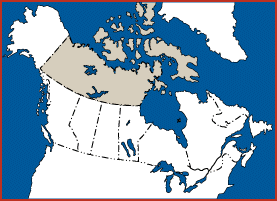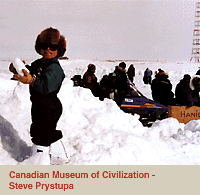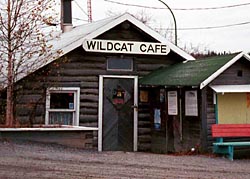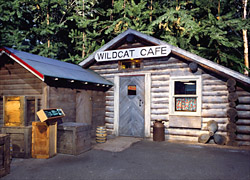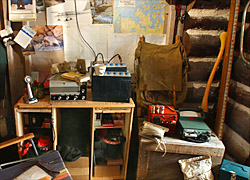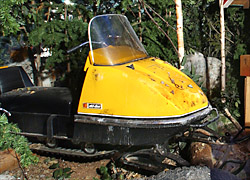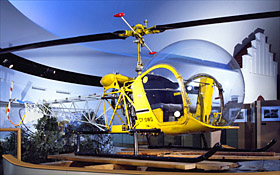
|

|
11. North of 60° —
Visions of the New North
|
As the final section of the Canada Hall, the exhibits emphasize that Canada is indeed a nation "from sea to sea to sea." Factors shaping the new North are be explored, including recent changes in transportation and communication technologies, the creation of new self-governing political institutions and economic organizations, and the increasing migration of northerners to urban settlements.
Northern Traffic (1945-2000)Since the end of the Second World War, major innovations such as helicopters, snowmobiles, and high-frequency radios have helped open and develop Canada's northern territories. Most Canadians take for granted the ease with which they can communicate and travel over great distances. Those in northern Canada do not. For the fewer than 100,000 people scattered throughout this vast region, creating links with each other and the rest of the country has never been simple. Faced with an extreme climate and a varied landscape, northerners have had to rely upon, and adapt, hardy machines to overcome the unique challenges of this Canadian frontier. Many of those machines– de Havilland bush planes, Bombardier Ski-Doos®, and Spilsbury high-frequency radios – are made in Canada.
Wildcat CafeIn the harsh conditions of Canada's northern frontier, prospectors, bush pilots, miners, and trappers established places where they could meet to exchange information and stories. Built in 1937, the Wildcat Cafe in Yellowknife, Northwest Territories, was a popular gathering spot which served at various times as an eatery, Chinese restaurant and ice cream and soda stand. At one time it even featured steam baths in an adjacent building – a useful service in a frontier town with limited water services. It also became a symbol of community and identity in a region where distance, a scattered population, and climatic extremes posed tremendous challenges. In the 1970s a volunteer group, the Old Stope Association, undertook to save the Wildcat Cafe from demolition after many years of disuse. It was one of the last remaining buildings in what had been the thriving commercial centre of Yellowknife in the 1940s. The Association would eventually renovate and reopen the building in 1979 as a restaurant featuring Northern fare such as caribou and fish.
These movies can be viewed with any Quicktime player, but are best viewed using Apple's Quicktime Player. If you wish to download the Quicktime VR Player click on the logo:
"Roger That!"The squawk of a high-frequency (HF) radio has long been a comforting sound to people working in remote regions of the Canadian North. By the 1970s, trappers, scientists, surveyors, firefighters, and exploration companies had come to rely on radios to transmit information to and from isolated camps. Their regularly scheduled radio communication (or "sked") could include weather reports, instructions from employers, or messages to a loved one. The radio also ensured their safety. If they missed their sked or reported an emergency, immediate action was taken to locate and retrieve them by bush plane or helicopter. The Canadian-made Marconi CH-25 was used extensively in the North in the 1960s and 1970s. It was not easy to transport, but it could reliably transmit and receive signals over thousands of kilometres. Just as efficient as the CH-25, but far more portable, the green SBX-11 radio was introduced by Vancouver's Spilsbury and Tindall Ltd. in the early 1970s. It was replaced within the decade by what became the most popular regional radio, and a symbol of the North, the orange SBX-11A. In the 1990s, satellite telephones capable of reliable communication from even the most remote areas of the North began to replace HF radios.
CBC NorthSoutherners working in the North huddled over their short-wave radios in the 1950s, trying to decipher voices through the static. For them, radio was an important link to the outside world. Responding to this group's needs, the Canadian Broadcasting Corporation (CBC) established a regional radio service in 1958. Covering close to five million square kilometres, the Northern Service featured national and international news, as well as unique northern programming. Over the years, the CBC's regional impact grew, along with its audience, as programming in First Nation languages and Inuit dialects steadily increased.
From Sled Dog to SnowmobileSnowmobiles roared into the Canadian North in the 1960s. By the end of the decade, they had become the preferred mode of winter land travel. Trappers, prospectors, mining companies, and the Royal Canadian Mounted Police all found that the machines required less care, were cheaper to maintain, and moved much faster than traditional dog teams – as long as they did not break down. Three decades later, snowmobiles remain the most economical way to transport people and light loads over the northern snow. The Ski-Doo®, manufactured by Canada's Bombardier Limited, continues to be a popular working snowmobile in the Canadian North. The 1972 Olympique model in the Canada Hall was collected in Yellowknife, Northwest Territories.
On a Different PlaneBush planes and helicopters opened up vast stretches of the Canadian North. Besides providing more rapid transportation for people and goods to isolated outposts, they were a more profitable way of discovering and exploiting the abundant natural resources of the region. Helicopters can land almost anywhere. This versatility has proven particularly valuable in the Canadian North. Before helicopters arrived, in the 1950s, surveyors, prospectors, and scientists mainly worked in regions where bush planes were able to land. Since helicopters did not require a flat runway or a lake to set down, they could reach places that were previously inaccessible by air, including wooded areas and mountain peaks. Their introduction significantly accelerated the mapping, surveying, and geological exploration of the North. Northerners also relied on bush planes. Three celebrated models, the Single Otter, the Beaver and the Twin Otter, were produced by De Havilland Canada in the post-war years.
The Bell 47D-1 HelicopterThe Northern Visions exhibit includes a Bell 47D-1 helicopter of the type which was used extensively in exploring and developing Canada's North. Its call sign is CF-GWD. The Bell 47D-1 has been positioned on top of a "cliff" overhanging the Wildcat Cafe replica. This is a tip of the hat to the risky conditions that sometimes faced helicopter pilots in the North. In high altitude, where the air is thinner, helicopters had a hard time leaving the ground. Pilots would then perch the craft on the edge of a cliff, where they would take off by "jumping," reaching sufficient speed in their descent to be able to take off and fly. The Bell 47D-1 could carry a pilot plus one passenger. With a Franklin 6V4-178-B32 air-cooled engine, the Bell – flying at a maximum speed of 153 km/h – could reach 3,962 m in altitude and had a range of 349 km. The first flight with this type of craft was made in Canada in 1949.
|
||||||

|
